A trip to Europe’s Northern countries is on the bucket list of countless people around the globe.
City trip through Oslo, on to Bergen’s beautiful scenery, hiking through the National Parks on the way, and then finishing in Tromsø with the Northern lights.
Perhaps there’s time for a quick stopover on the Lofoten Islands.
But for us dog owners that’s definitely not the reality.
Unless you’re considering boarding your dog or leaving him with friends or family back at home, you’ll have to do a lot more planning.
What some consider to be mere stepping stones, others perceive as insurmountable obstacles, potentially causing them to not go or at least not with their canine.
Entry restrictions, hotel choice, restaurants, spots to exercise your dog, and how to even get there – just to name a few.
One thing is for sure, traveling without a dog is more convenient, faster, and perhaps even cheaper.
But who wants to go on a trip to Norway or Sweden without their furry friend?
I didn’t.
I’ll shed some light on how to road trip through Norway for dog owners so you have the best possible experience.
That includes entry advice, whether or not Norway and Sweden are pet-friendly, how to drive safely with a large dog, and where to stay.
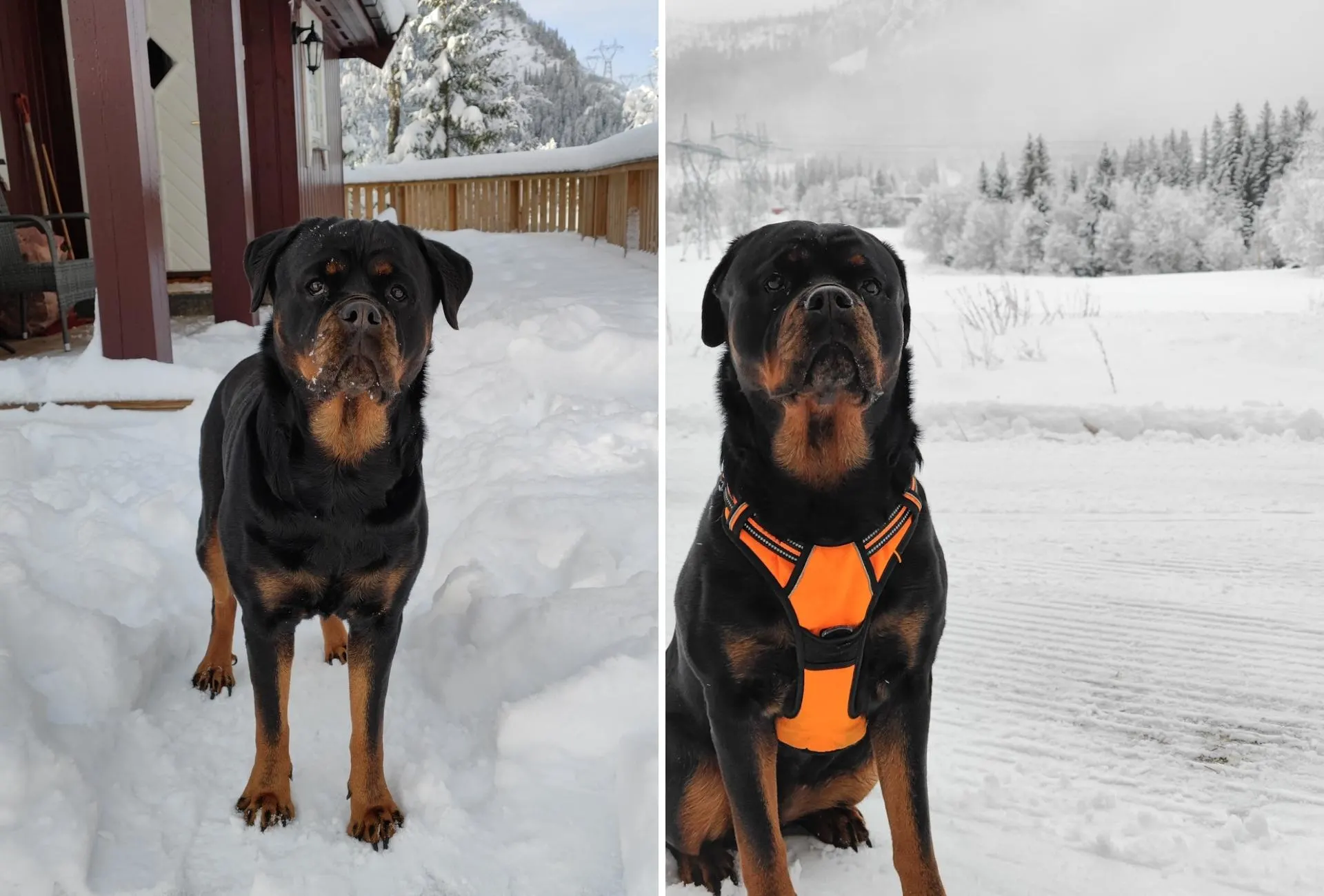
As if traveling almost 2,500 miles with a dog isn’t enough, we did all that with a Rottweiler.
More space requirements, exercise needs, restrictions, and more questioning eyeballs wherever you go with your 100-pound dog.
Road Trip To Norway or Sweden With a Dog: Before You Go
Bureaucracy. Drags you down even before you’ve started, right?
Well, sometimes it’s just a box to check, other times, not so much.
Entry requirements for dogs differ from country to country and you should check out all available resources on government sites before crossing the border with your dog.
You’ll probably need to vaccinate your dog, get your pet passport up to date, fulfill special requirements (see Norway), and cross the border with the appropriate paperwork.
If you’re coming from outside Europe, all the paperwork might take even longer and can be associated with extra costs.

Honestly, I probably wouldn’t recommend flying here and then going on a road trip since that would require your dog to fly in cargo.
The only option to get around cargo is if you have a service dog, a very small dog (only some airlines), or if you fly privately (hint: $$$).
Sweden Entry, Border Crossing, No Banned Breeds
Luckily, Sweden has very simple entry requirements for EU citizens.
As long as your dog fulfills the requirements (basic stuff such as ID, rabies vaccination, pet passport), you can quickly register your dog online.
After you registered your dog online, you just cross the border and – only if asked – show the email containing proof that you’ve registered your dog.
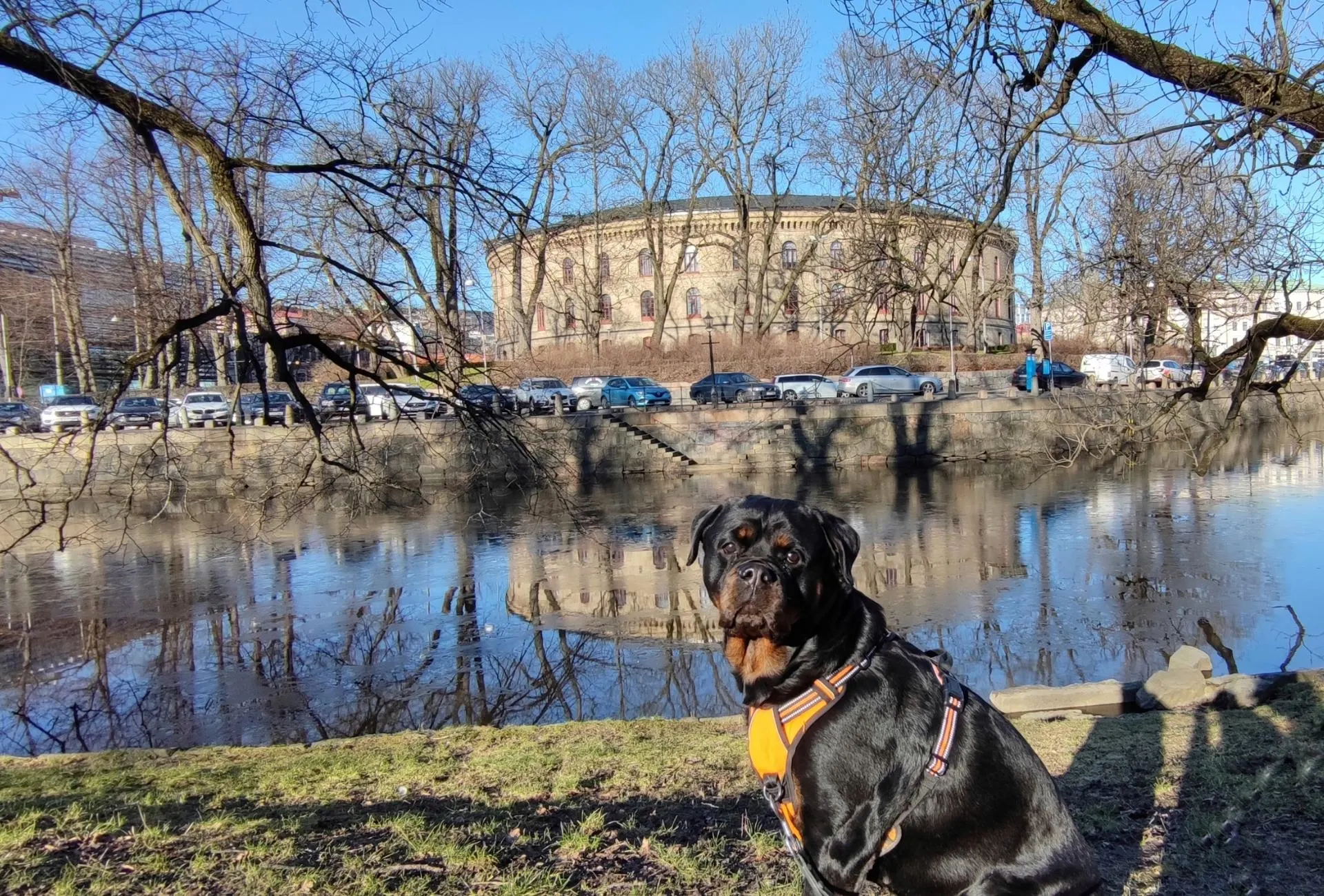
Sweden does not have breed-specific legislation.
That means every dog breed is allowed to enter without any bans or restrictions such as muzzles or a short leash (you still need to adhere to local laws and leash your dog in most areas, of course).
Wolf hybrids or dogs proven to be aggressive can be prohibited.
If that’s your dog, you’ll need to do more research before coming to Sweden and perhaps might not be able to at all.
Norway Entry, Vet Certificate, Red Channel, Banned Breeds
Norway was a bit more difficult.
The basic requirements were the same, plus you have to treat your dog for the fox dwarf tapeworm in a certain timeframe and cross the border through the red channel.
You still have to register online but for yourself instead of your dog since you’re already presenting your dog at customs.
As per their website, this is the treatment you need:
(…) a signed confirmation by a veterinarian stating that the dog has been treated with praziquantel against the Echinococcus multilocularis tapeworm. The treatment must be given in Sweden no less than 24 hours and no more than 120 hours before entering Norway. The treatment cannot be given in Norway prior to departure (…)
Norway customs
We planned to go through Sweden first and were in a bit of a pickle since that only left a window of 1-2 days for the treatment but luckily, our vet was able to squeeze us in which is awesome.
Keep in mind that you do need a certificate (in your pet passport) with a timestamp and the vet’s signature.
If you stay anywhere else before coming to Norway, you’ll probably have to seek out a vet in that country before coming to Norway (it does seem to be pretty common knowledge among vets in Sweden though).
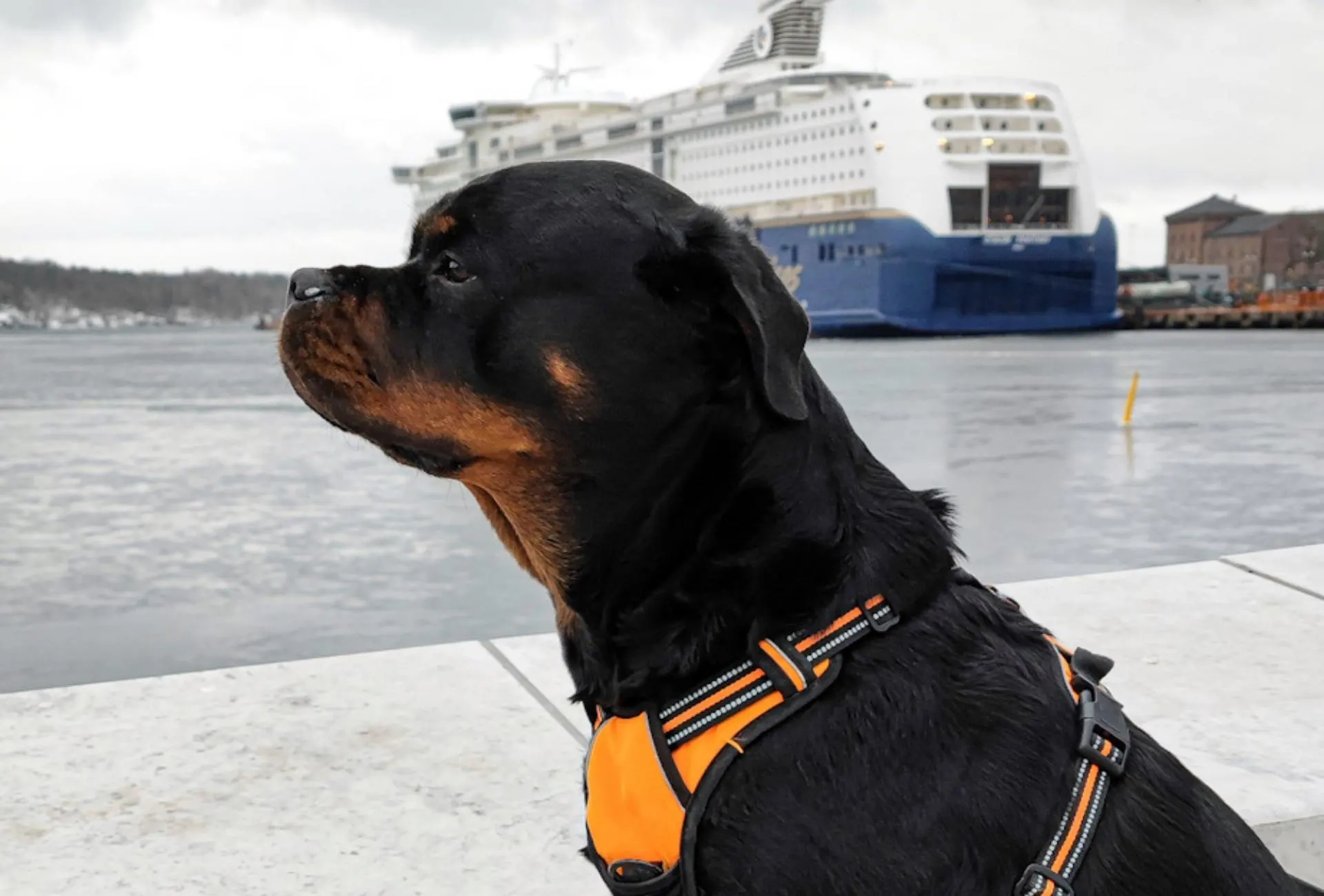
You’re trying to keep it natural and follow a more holistic approach and unnecessary worm treatments are not part of your plan?
I totally understand dog owners disliking unnecessary meds.
Yep, that was a bit of a concern of mine since I just regularly have my dog tested for worms and then treat if necessary.
Luckily, my dog handled the deworming superbly as there were no issues at all (she didn’t even seem tired).
If you know your dog reacts to the deworming medication, plan for that ahead and don’t give it exactly 24 hours before departure.
Border crossing tip: Not every border crossing has customs where you can go through the red channel. It’s up to you to choose the right border.
As we later found out, the customs office does not have to approach you, you have to present your dog and if you’ve skipped them, it’s really difficult to find the right office inland.
Nobody asked to inspect our dog but the papers were in order so be prepared and follow their guidance.
We did our research but the navigation system did us dirty and we would’ve missed customs on the toll-free route so be aware of that too.
Dog owners of commonly banned breeds, keep reading since Norway does place restrictions on certain breeds.
Is Sweden Dog Friendly?
On our road trip, we found that Sweden is okay when it comes to how dog-friendly everything is.
Off the top of my head, there aren’t many countries that are truly dog-friendly at all.
Since Sweden doesn’t have breed-specific legislation, makes the entry pretty easy, and has a lot of nature, that makes the country inherently more dog-friendly than other densely populated countries.
However, when it comes to dog parks or stuff to do specifically for dogs, it’s okay but nothing compared to big cities in the USA (or even many rural areas).
Restaurants are not keen on seeing a large Rottweiler but people definitely seemed more open.
Usually, dogs are allowed in parks.
However, that depends on the park or sight and it might also depend on the season.
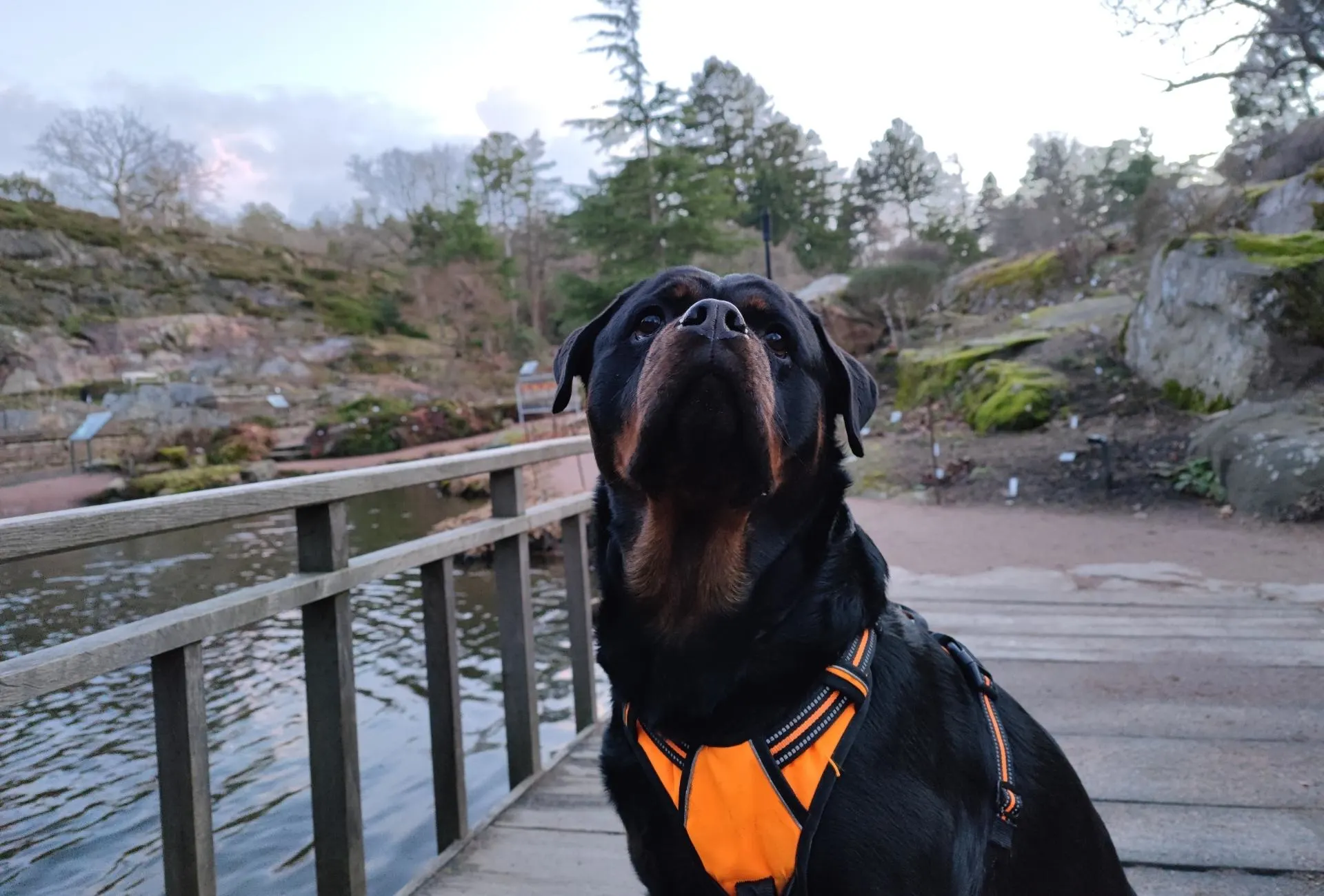
The botanical garden in Gothenburg only allows dogs between October 1 – February 28 so we were lucky to fall between these dates.
Is Norway Dog Friendly?
Norway was middle of the road when it comes to how dog-friendly they are.
In the capital, Oslo, there certainly are businesses that allow dogs but generally, it didn’t strike me as a dog lover city.
Sure, if you live in the countryside, there’ll be lots of space, but not so much in the city.
We truly enjoyed our cabin stay in Hol where there was practically only one neighbor in that relatively secluded area.
That meant lots of roaming around freely for Amalia after more than a full day of driving.

Sadly, banned dog breeds include the Pit Bull Terrier, American Staffordshire Terrier, Fila Brasiliero, Tosa Inu, Dogo Argentino, and the Czechoslovakian Wolfdog.
The Norwegian Food Safety Authority states on its website: “If there is doubt about the breed, the police can have the dog killed or require that the dog be sent out of the country.”
Since the evaluating authorities are often severely undereducated in evaluating breeds, there’s a fair chance your rescue Staffordshire Bullterrier, Bullterrier, or simply Mastiff will be identified as one of the above.
Road Trip To Norway with a Large Dog: Car Safety, Stops, Parking
When you come to Norway by car, you’ll probably encounter some space issues if you have a large dog.
Our car is pretty spacious in the back but not exactly a huge SUV. Depending on your car, I’ve found several possibilities.
We folded down the back seats to ensure Amalia had all the space in the back since we only needed one piece of luggage and a couple of things that could be stored behind the front seats.
This also ensures that she has her own bed at the Airbnbs.
Next, you gotta make sure your dog is secure.
We used her regular harness and just clipped on a bungee-style car seat belt that has a clip (like a leash) on one end and a car seat buckle on the other.
Despite it looking a bit more jumbled here than it really was, I’d probably recommend using a steel crate instead or just placing your dog in the backseat and using a crash-tested harness.
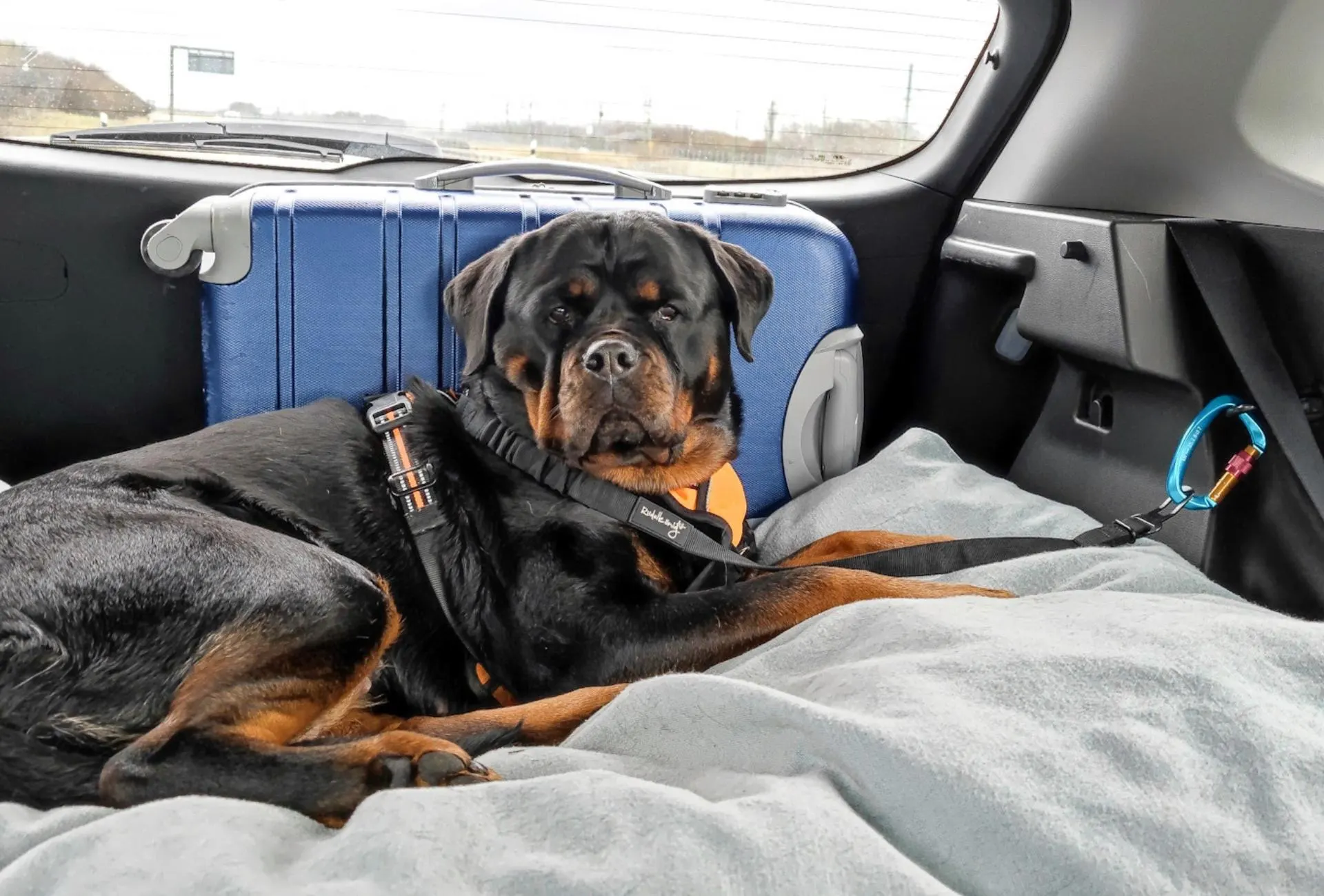
Since her seat belt didn’t reach any place where we could buckle it in, we just used a carabiner and attached her buckle to that.
The carabiner was made to withhold 25kN (up to 5500 pounds), fulfilled the EU norm, and is made from aluminum used in aircraft materials.
If there’s a weak link, it’ll probably be the metal buckle on the car seat belt, the clip on the car seat belt, or even the place where the clip is stitched into her harness.
Depending on where you’ll start, the time spent driving will vary greatly.
For us, the total was around 2,500 miles (4,000km) and around 48 hours inside the car.
The first stretch to arrive in Malmö alone was a 10-hour drive.
Since we’re traveling in an EV, charging stops are longer than usual but it wasn’t that big of a deal at all as we almost always used the time to walk our dog.
I really wouldn’t recommend spending more than 2-3 hours at a time inside the car.
Per day in total, you should probably aim for 4-6 hours, unless you really need to cover a huge distance as quickly as possible and your dog can stomach it.
Some dogs vomit as soon as they spend a couple of minutes driving while others seem to sleep through the drive.
Amalia definitely errs on the side of liking the car ride and she did great but even then, I’d limit the time spent on driving per day and extend very short stays by a day or two to give your dog time to recover.
That’s what we did on our way back to Helsingborg. We never stayed less than 2 nights.
Once you’ve arrived, you need to make sure that you have a parking space.
The same applies if you quickly want to grab a bite. You definitely don’t want to leave your dog in the car without supervision for too long.
All these things will be kind of limited if you bring your pooch.
You also need to adjust sightseeing to the outdoors part or indoors if dogs are allowed.
We did leave our dog inside the car for a couple of minutes if it was absolutely necessary.
Now, where should you stay with a large dog?
Below, I’ve collected all the necessary tips to make your Norway road trip with your dog successful by hopping from Airbnb to Airbnb.
Pet Friendly Airbnbs in Norway & Sweden
My biggest advice on finding a pet-friendly stay is to use Airbnb’s pet filter and check whether or not extra fees or restrictions apply.
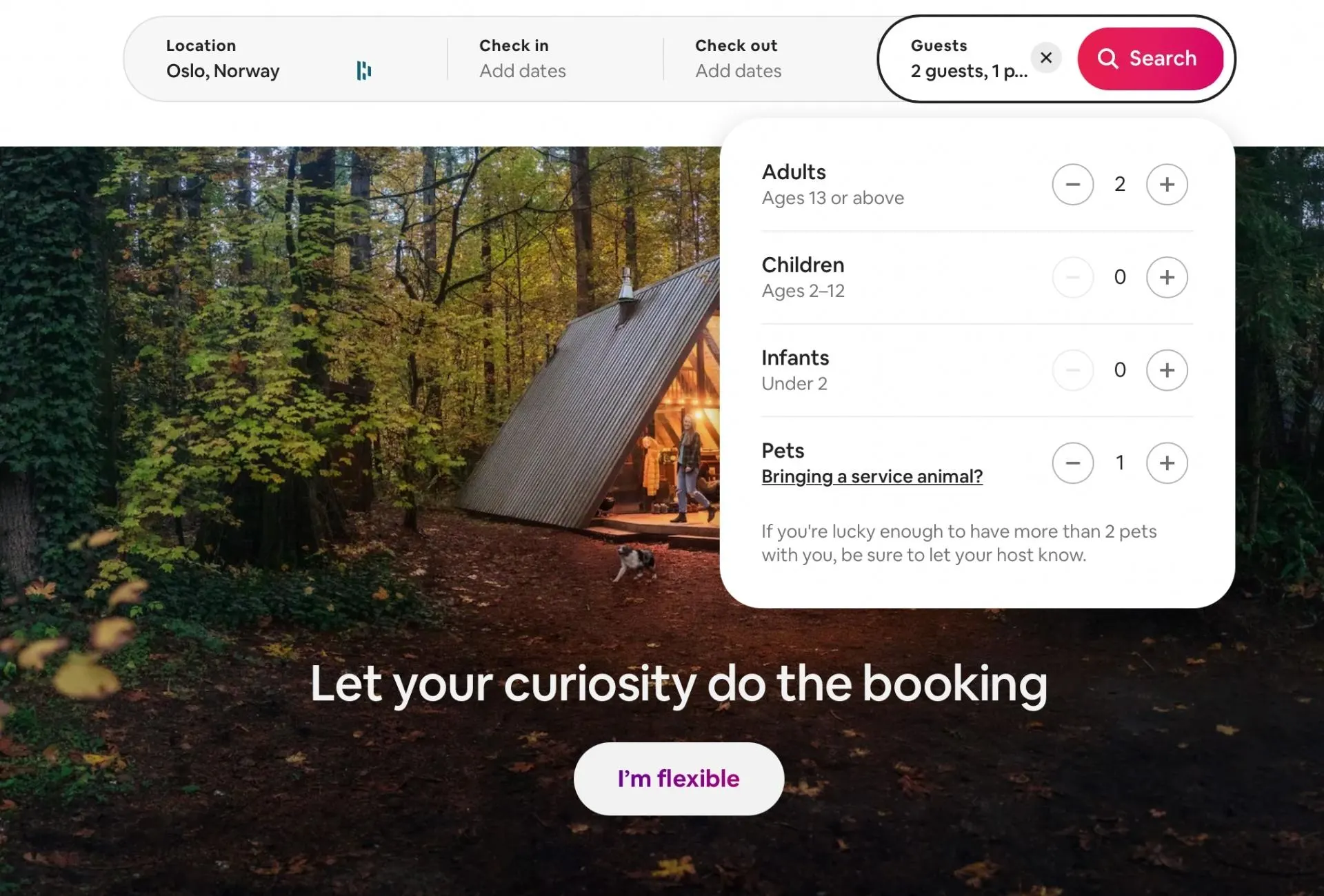
Previously, the website had a dedicated pet filter, now it’s only asking you with whom you’re traveling.
I’d definitely suggest checking that box since otherwise, you’ll be shown stays that don’t allow pets.
In my experience, your choice is usually limited to 25-50% of all stays, depending on the location.
It’s usually not worth it to check stays with a “no pets” policy just to try to convince them (unless it’s the only stay you like in the area).
Chances are slim that you’re changing the host’s mind, but maybe it’ll happen.
Many hosts don’t allow pets due to allergies or no-pet policies in their apartment complex which is fair.
However, many will just never take the gamble on having stuff destroyed, dog smell inside the house, annoyed neighbors, or they simply don’t like dogs.
Even if your Airbnb allows pets, there might be restrictions.
Some hosts don’t want large dogs or certain “dangerous” breeds while others charge an extra fee or want to be informed ahead of your arrival.
Where We Stayed With Our Large Dog in Sweden & Norway
Here’s the list of Airbnbs we’ve visited:
- Airbnb Malmö
- Airbnb Gothenburg
- Airbnb Oslo
- Airbnb Hol
- Airbnb Helsingborg (currently not available)
Cities are always a bit stressful so we mostly chose apartments on the outskirts and it was perfect.
The drive to our Gothenburg Airbnb was really curvy and hilly so beware if you have a dog who gets sick in the car.
Staying at an Airbnb in Oslo might seem like a hassle but shortening the stay may be a good compromise.
Restaurant choices were great and Oslo takes the cake for variety, but the lack of parking spaces made things rather difficult.
Hol was probably our absolute favorite and if you’re traveling to Norway with a large dog, I’d recommend staying at a somewhat secluded place at least once.
Lots of running around after countless hours spent driving and just being able to go outside with your dog unleashed is awesome.
You’ll need to cook for yourself though in most places which means more time spent with your furry friend.
Would I Recommend Norway with a Large Dog?
Yes, I would recommend traveling through Norway and Sweden with a large dog due to the beautiful nature.
Road-tripping through Norway is awesome since it allows you to observe some of the most beautiful scenery when driving around the National Parks.
Not going beyond Oslo or flying from city to city means missing out on the beautiful drive from Oslo to Bergen with mountains and breathtaking lakes.
All in all, I can recommend packing your things and going on a road trip if bringing your dog is important to you. Norway is a great destination to do just that.
Disclaimer: This blog post does not substitute veterinary attention and does not intend to do so. I am not a veterinarian or pet nutritionist. If your dog shows any sign of illness, call your vet.